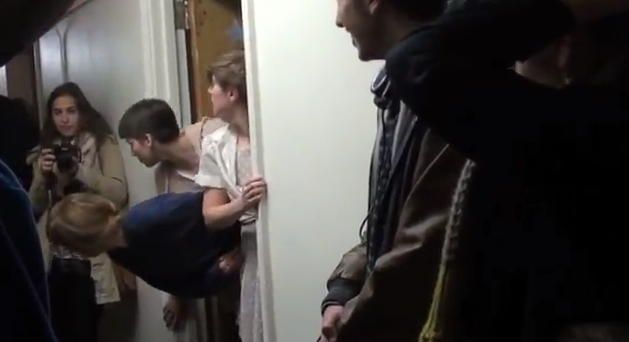Last Thursday, a group of artists transformed the second floor of Smith into an art venue combining “visual art, postmodern dance, theatre, improvisation, oral hygiene and food processing” in a piece called perDORMance Art.
The concept was formed over a year ago as a “collaborative idea and effort by the [now] senior dance majors,” said Grant Jacoby ’13. It took shape when dance professor Lisa Race suggested they pursue it, and the nine seniors — Jacoby, Skyler Volpe, Liz Charky, Jeramie Orton, Candace Taylor, Chloe Spitalny, Amy Gernux, Rachel Pritzlaff, Sammi Shay and Ayano Elson — banded together to put the idea to reality.
They had an idea; they had a venue. Word spread via Facebook with seventy guests attending by show time.
The crowd was small when I got there a little before 8 PM, but it wasn’t long before, by my estimates, seventy of us waited anxiously to see what was in store.
When we walked into the hallway, we were told to look for the doors with paper cutout stars, marking where art was happening. A few stars were on doors of students’ rooms, one on the bathroom door and one outside the pantry, but the clusters of people in the doorways were were the best indicators that something was happening there.
Each room had distinct inhabitants, each with their own motives: Pritzlaff scrolled on her computer while Orton danced in the background; Jacoby laid on the bed as Spitalny rolled on the floor, slowly crumpling up the tin foil that was absolutely everywhere (and I make that point again to make sure you understand that it was everywhere).
Then, Volpe started to panic because there was no cayenne pepper. Where was it? Why does this matter? Before we could begin to ponder such topics, our focus moved to the hallway where each dancer ran back and forth in different pairings. The dancers moved through “the human tunnel,” as Orton put it, by dragging each other, carrying each other, flying into each other’s arms and generally testing the limits of improvisational dance.
By the end of the night, each dancer had either 1) rolled or been dragged across the floor, 2) learned one or a number of audience members’ names or 3) found themselves completely displaced or disoriented, yet happy. Their artistic liberty led them to a space surrounded by us, an audience amazed by what had just happened.
The dedication to the art was evident. Jacoby covered pretty much every surface in his room with tin foil (then he and Spitalny ripped it up in an elegant cacophony). Shay took the bed out of her room and put it in the bathroom, and Charky and Elson bounced, pushed and held onto it for dear life. And that’s just the half of it.
Yet, unlike art that entails rehearsal upon rehearsal in the lead up to a performance, this art was based on improvisation. Dancers relied solely on instinct and training in their performance. For those of us who ever dropped a line in a school play, this thought can make the heart drop. In this context, however, the result was the opposite: Volpe said that, “a bunch of people praised it as the most honest performance they’d seen in a while, and that was probably the best compliment I’ve received about the whole thing.”
The night challenged our dynamic of art in space. As Jacoby said, it “provided a new lens for dance and performance on campus.” As Camels, we relish the opportunities to see a Dance Club show or a theater department production, however the dancers all touched on how formalized these performances are. PerDORMance art “stood out,” Shay said. “I realized after we did this that the majority of our campus hasn’t been exposed to very much of this kind of performance. In my experience here, site-specific performance has been a somewhat rare occurrence. I hope that our show inspires that to change; I’d be ecstatic to see more site-specific performances on campus that are open and engaging to the entire community. But also in my experience, the ‘art world’ on campus is pretty open-minded and experimental, which is probably why the audience appreciated it and so many people really connected with it.”
Volpe said it solidified how accessible art is to all of us. Art rocks because it can be in a quiet gallery, or it can be literally right down the hall. It waits for you at every turn. It doesn’t have to be “sacred, or far away, or elite. It can be right in your bedroom, or in your bathroom or in your awkward pantry with two sinks.”
This was the first year for perDORMance art, but hopefully not the last. Jacoby said that it laid the groundwork for a future trend of out-of-the-box thinking, which could manifest itself in new classes (note the theater department’s sophomore research seminar: “Occupy Blank: The Art of Protest”), new productions, new whatever we can think of from outside that box. I personally would love to see perDORMance art again, be it in Smith or Fanning or wherever it finds itself.









